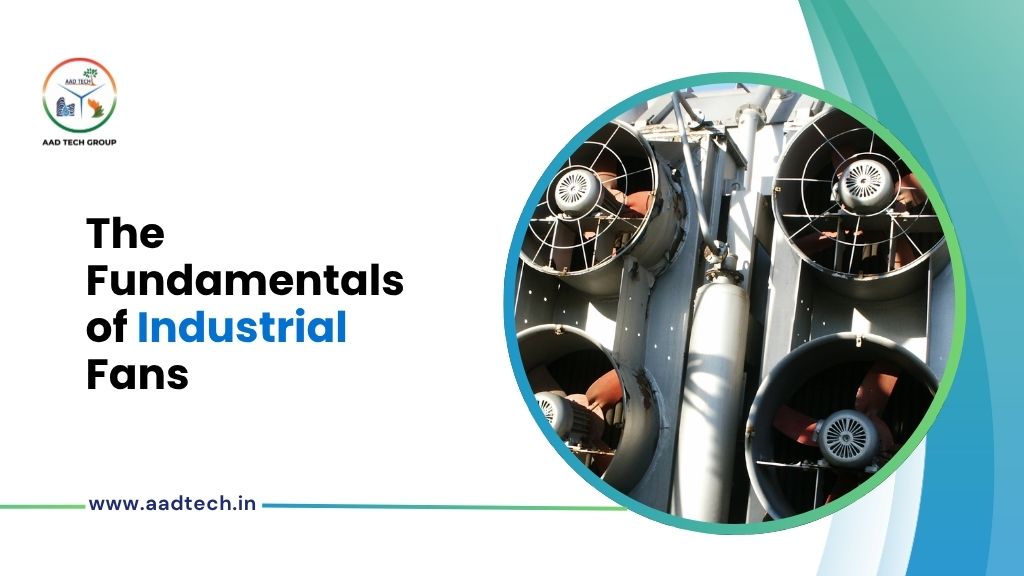Industrial fans are essential devices in numerous applications, factory floors and power plants, clean rooms, and commercial HVAC systems, to name a few. Whether providing air quality maintenance, cooling machinery, or facilitating air exchange within closed environments, fans are essential devices for maintaining operational efficiency and environmental standards.
Knowing the types of industrial fans is important, as it will help you choose the proper system for your building. Selecting the proper fan type can boost energy efficiency, lower operation expenses, and prolong the life of attached HVAC equipment. At AAD Tech India, our industry professionals specialize in advanced ventilation and energy optimization technologies and emphasize the importance of understanding fan fundamentals to make informed, effective decisions.
Why Fan Classification Matters
Fans are not universal. Every industrial setting has individual airflow requirements, temperature ranges, particulate burdens, and space limitations. Classification of fans enables segmentation of fans according to their performance metrics so that engineers and maintenance personnel can equate fan specifications with operating parameters.
There are three fundamental classifications of fans depending on their airflow direction and pressure characteristics:
- Axial Fans
- Centrifugal (Radial) Fans
- Mixed Flow Fans
Want to cut energy costs? Here’s what to upgrade in your HVAC system.
Axial Fans: High Flow, Low Pressure
Axial fan systems blow air parallel to the direction of the fan shaft. It is propeller-like and is generally installed where high volume-low pressure air movement is needed, like in cooling towers, exhaust systems, and process ventilation.
Key advantages are:
- Basic design
- Lightweight and compact
- Low maintenance and initial cost
Despite that, axial fans are not well-suited for high-resistance systems, so they are best used where there is free airflow or low static pressure.
Centrifugal Fans: Designed for Pressure
Unlike axial fans, centrifugal fans have air traveling perpendicular to the fan shaft through a rotating impeller. When air is introduced to the center, it is flung outward by the force of centrifuge, enabling these fans to produce higher pressures.
Used in:
- Dust collection systems
- HVAC ductwork
- Industrial furnaces
Key advantages are:
- High-pressure ability
- Improved performance in systems with resistance
- Reduced noise at comparable operating speeds
We suggest using centrifugal fans for customers requiring energy-efficient air movement in long or constricted duct runs of systems.
Thinking of switching to EC fans? Check the difference between conventional and EC fans.
Mixed Flow Fans: Best of Both Worlds
Mixed flow fans integrate axial and centrifugal concepts. Air is introduced axially but discharged at an angle, providing these fans with a combination of high flow rates and average pressure.
Used in:
- Parking garages
- Tunnel ventilation
- Industrial enclosures
Mixed flow fans provide a compromise solution when both performance and spatial effectiveness are equally important.
Fan Performance Ratings and Standards
In the classification of industrial fans, performance factors such as CFM (cubic feet per minute), static pressure, efficiency, and noise level are involved. Reliable manufacturers tend to adhere to Air Movement and Control Association (AMCA) standards to provide reliable and consistent performance ratings.
For system designers, knowledge of these ratings assures the fan chosen is proportional to the building’s air exchange needs while maximizing energy efficiency. Our engineering staff regularly performs on-site airflow diagnostics to ensure their HVAC applications meet changing safety, environmental, and performance requirements.
Picking the Right Fan
To find the best industrial fan, factors:
- Air volume and pressure needs
- Temperature and humidity conditions
- Contaminant concentration or corrosive substances
- Space and noise limitations
- Operational cost targets
In most retrofit and energy upgrade projects, collaborating with an experienced HVAC engineering team can result in significant energy savings. Our expertise in industrial ventilation and energy recovery systems allows us to select performance-optimised fans that balance airflow, cost, and sustainability, making every upgrade efficient and future-ready.
Conclusion
Industrial fans may appear straightforward, but their role in large-scale air movement and system efficiency cannot be underestimated. Whether it’s selecting a fan for a manufacturing facility or upgrading an outdated HVAC system, understanding fan classifications is the foundation of smart engineering.
With a reliable partner like us, companies can deploy systems that drive performance, minimize downtime, and facilitate long-term sustainability objectives. As buildings require more out of their air-handling systems, the appropriate fan, supported by the proper expertise, can be the difference-maker.


